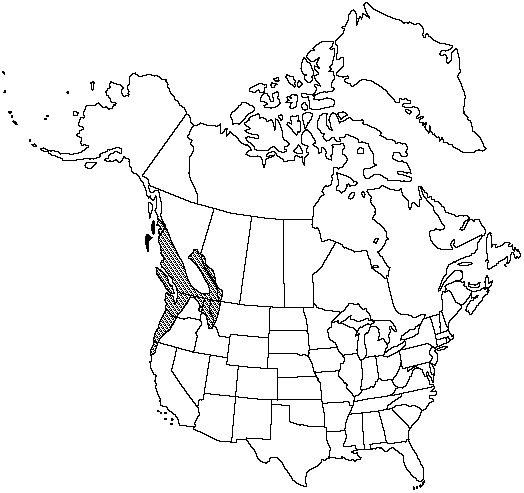Thuja plicata
in Lambert,Descr. Pinus 2: [19]. 1824.
Trees to 50 (–75) m, sometimes stunted in harsh environments; trunk to 2 (–5) m diam., often buttressed at base; crown conical. Bark reddish-brown or grayish brown, 10–25 mm thick, fibrous, fissured. Branches arching, branchlets pendent. Leaves of branchlets (1–) 3–6 mm (sprays sometimes bearing only very small leaves), apex acute, with white markings on abaxial surface when fresh, glossy green on adaxial surface of branchlets. Pollen cones 1–3 mm, reddish. Seed-cones ellipsoid, 10–14 mm, brown; fertile scales 2–3 pairs, each with evident, nearly terminal, deltate projection. Seeds 8–14 per cone, 4–7.5 mm (including wings), reddish-brown. 2n = 22.
Habitat: On various substrates, commonly in moist sites, mixed coniferous forests, usually not in pure stands
Elevation: 0–1500(–2000) m
Distribution

Alta., B.C., Alaska, Calif., Idaho, Mont., Oreg., Wash.
Discussion
The range of Thuja plicata consists of a Coast Range–Cascade Range segment from southeastern Alaska to northwestern California (between 56° 30' and 40° 30' N latitude) and a Rocky Mountains segment from British Columbia to Idaho and Montana (between 54° 30' and 45° 50' N latitude).
Thuja plicata is an important timber tree. Its soft but extremely durable wood is valued for home construction, production of shakes and shingles, and many other uses. Native Americans of the Northwest Coast used it to build lodges, totem poles, and seagoing canoes. Many cultivars are grown for ornament, and the species is managed for timber in Europe and New Zealand.
Western redcedar (Thuja plicata) is the provincial tree of British Columbia.
Selected References
None.
Lower Taxa
"with slightly enlarged apex" is not a number. "thin" is not a number. "thin" is not a number.